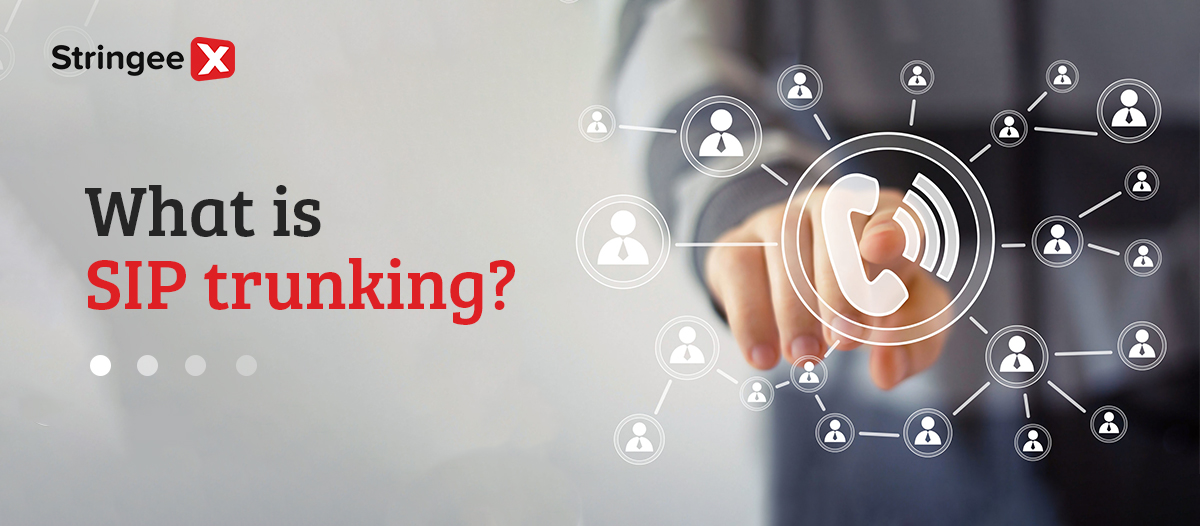In the ever-evolving world of technology, businesses are always looking for ways to improve their communication infrastructure and stay ahead of the competition. SIP Trunking is a modern telecommunication technology that offers a cost-effective and scalable solution to enhance your business communication.
In this blog, we will dive into the basics of SIP Trunking and explore how it can benefit your business. From improving call quality to reducing costs, SIP Trunking is the future of business communication. Read on to learn more about this innovative technology.
What Is SIP Trunking?
Session Initiation Protocol, or SIP, is an application layer protocol that enables you to use your phone system through the internet rather than traditional phone lines. To connect to a telephone network, many customers utilize a backbone of phone lines known as trunking.
SIP Trunks offer Voice over Internet Protocol (VoIP) connectivity between an on-site phone system and the PSTN, also referred to as the public switched telephone network. For instance, a business might already offer phone service through a PBX. For the entire office to be able to communicate with the outside world, SIP trunks provide phone service.
How Does SIP Trunking Work?
SIP is the most widely used format in IP telephony. This protocol creates a VoIP connection over the internet. With SIP, you can:
- Talk to one other person on the phone
- Have a conference call with several people
- Conduct video calls
SIP trunks act as the link between your company's phone system and the Internet Telephony Service Provider (ITSP).

Previously, businesses used Integrated Services Digital Network (ISDN) lines that had to be placed physically on their premises. SIP trunking now routes voice conversations in these circuits over data networks rather than over copper lines. In other words, virtual infrastructure takes the place of physical infrastructure.
To switch to SIP trunking, you'll need the following configuration:
- Internet access
- PBX (Private Branch Exchange) box that is SIP-compatible, often known as an IP PBX VoIP phone, or VoIP adapter if you intend to use your current traditional phones
- Internet access for your phones
Types Of Businesses Should Use SIP Trunking
Indeed, any business can leverage the advantages of SIP Trunking. SIP Trunks are a fundamental component of every IP PBX. If you're new to phone systems or switching from an analog PBX, you can choose between an on-premise IP PBX and a full cloud-hosted PBX system.
Businesses with the following traits are best fit to use on-premise hardware along with SIP trunks:
In-house IT managers and telephone experts
Professional installation and maintenance are necessary for on-premise PBX systems. These can be organizations or managed service providers, but you will also require at least one inside contact who is familiar with telephone systems. On-site PBX systems can be highly expensive in the short term when paired with the essential setup and maintenance.
Considerable call volume
Any company or location that receives a lot of both inbound and outgoing calls needs the flexibility and affordability that SIP Trunking offers. It is very likely that call centers, such as sales or support hubs, will use more complex PBX systems supported by specialized high-volume SIP services.
With the drawback of costing more upfront for gear and setup, choosing the correct SIP provider for these companies and their calling profile can result in significant cost savings in the long run.
>>> Read more: What Is Direct Inward Dialing?
Benefits Of SIP Trunking
Cost saving
You can be paying for additional lines you aren't utilizing if you have a standard phone line. Additionally, costly long-distance and international call rates may apply. The price of maintaining the equipment is another factor.
SIP trunking offers simplified pricing, typically based on a per-user basis. This also has the added benefit of making your recurring spending predictable.
Unified communication
SIP Trunks are a key component in connecting an organization's various communication channels into a single, integrated solution, including calls, texts, emails, instant messages, and conference calls.
Since trunking is a virtual installation rather than a physical one, organizations should anticipate trunks to be up and running quickly—even in less than 48 hours. Most of the time, businesses may connect to the internet using their current infrastructure and connectivity without the need for further installation.
Experienced and knowledgeable SIP Trunk suppliers can assist you in finding the ideal service combination quickly and easily. Fast, dependable internet connections are essential, as are having contemporary IP PBX and IP-enabled phones.
Geographic flexibility
SIP trunking has a lot to offer in terms of flexibility and mobility for your staff. Only when you are close to your phone can you accept calls on a conventional phone system.
Voice calls can now be effortlessly routed to employees' mobile phones. This implies that they are also simple to contact when working remotely, such as when working from home or when on the road.
Fraud prevention
For all of your conversations, your SIP provider can provide enhanced security. SIP trunks establish a direct connection with you. Your connection is better protected as a result of potential social engineering assaults.
Additionally, suspicious call activity is watched for on SIP trunks. This guarantees that if someone manages to access your data network and tries to place calls, they will be promptly apprehended.
Employee productivity improvement
Among the many factors that contribute to projects failing are poor communication and shifting priorities. Does the communication system you have in place for your company permits easy communication between offices and employees? Your timelines and objectives could suffer if not.
A secure SIP trunking service has a straightforward advantage. Your staff can focus more of their time on productive work and less time trying to figure out how to contact someone.
Additionally, you have access to reporting and raw call logs so you can gauge usage and availability. IT specialists and business owners may expand their phone systems to meet the needs of their staff thanks to this feature.
Future preparation
Combining voice and data services with traditional lines has long been possible thanks to ISDN. However, in today's world where connectivity is crucial, the reliability and strength of a company's internet connection, as well as the efficiency of the services they utilize, play a major role in shaping their business telephony.
Adoption of IP-based PBXs, whether on-premise or cloud-based, has become an essential requirement for modern businesses.
Final Thoughts
SIP Trunking is a cutting-edge technology that has revolutionized business communication. It offers a scalable, cost-effective, and efficient solution to enhance call quality, streamline communication infrastructure, and improve overall business operations. As the world continues to evolve, SIP Trunking will only become more important in shaping the future of telecommunication.
Whether you're a small business or a large enterprise, SIP Trunking is a technology that should not be overlooked. If you're looking to enhance your business communication, consider exploring the benefits of SIP Trunking and how it can help you stay ahead of the competition.










